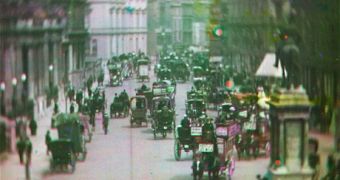The earliest motion picture uncovered so far was captured by Edwardian photographer Edward Turner in 1902. Curators at the National Media Museum in Bradford, England followed Turner's guidelines, as described in his patent, to align the frames of the picture and bring it back to life.
Edward Turner recorded successive frames through red, green and blue filters, projected the frames and then used superimposition to connect them.
He died at 29, in 1903, before he could perfect his methods. His achievements were never recognized during his lifetime, and, 10 years later, Technicolor was invented and stole his thunder.
According to The Telegraph, Turner was only 27 when he captured on tape his three children, a macaw, and the earliest color footage of the streets of London.
He was working as a photographer in London at the time. His work was considered futile after his film turned out blurry due to image layering.
In order to produce his movie, young Turner turned to well-off horsebreeder Frederick Lee. The two took out a patent in both their names, and the photographer started experimenting with 38mm films in 1901.
After his early demise in 1903, his equipment and notes were passed on to George Albert Smith, who went on to invent Kinemacolor in 1906.
Smith had tried to put together Turner's film, but gave up after realizing that the frames had to be perfectly aligned, and the projection speed that this process implied was 48 frames per second.
That was impossible at the time, and the film remained in the archives of cinema pioneer Charles Urban until it was sold to the Science Museum, in 1937.
Nobody had been able to rescue the film from anonymity until, 110 years from Turner's attempts, curators at the National Media Museum realized they could use digital technology to align its frames.
"Film historians had known about this process but always regarded it as a failure. We proved that his process worked. But the number of people who saw Turner’s films can be counted on one hand and we had to wait for digital means to produce his images the way he envisaged them,” Paul Goodman, head of collections at the museum, said.
“Edward Turner is the father of moving colour images,” he added.

 14 DAY TRIAL //
14 DAY TRIAL // 